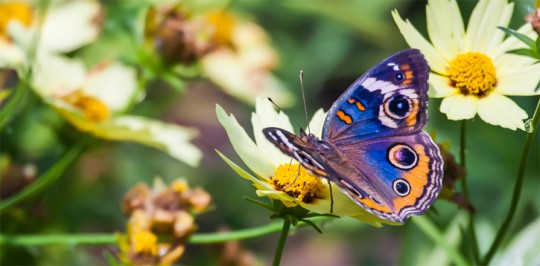Weekend Gardening: Plant Your Own Butterfly Garden
April 13, 2013
Butterflies are not only beautiful to look at in your landscape; they serve as important pollinators of your fruiting plants. Attracting them to your garden and incorporating some features to get them to stay and reproduce involves a little planning ahead of time for optimum results.
Choose a location that provides some protection from wind. Trees and shrubs that provide wind protection also serve as a safe harbor from rain and predators. The garden should be mostly sunny with some part sun areas. Ensure that any new plantings have access to a convenient irrigation source so they can be successfully established and maintained in good health.
 Now you’ll need to choose the plants. Adults feed on the nectar of many flowering trees, shrubs, perennials, and annuals and, fortunately, there are usually many choices that will meet your site requirements and your taste preferences. In order to keep the butterflies in your garden, certain plants need to be available to serve as host plants for their young. Determine which species of butterfly is common in your area and that you want to attract. Most species have very few plants on which the caterpillars can feed so those host plants need to be chosen wisely. Determine whether any of the plants you already have are host plants and they can be integrated into your butterfly garden. For example, cassia is a host plant for the Cloudless Sulphur and citrus is a host plant for the Giant Swallowtail.
Now you’ll need to choose the plants. Adults feed on the nectar of many flowering trees, shrubs, perennials, and annuals and, fortunately, there are usually many choices that will meet your site requirements and your taste preferences. In order to keep the butterflies in your garden, certain plants need to be available to serve as host plants for their young. Determine which species of butterfly is common in your area and that you want to attract. Most species have very few plants on which the caterpillars can feed so those host plants need to be chosen wisely. Determine whether any of the plants you already have are host plants and they can be integrated into your butterfly garden. For example, cassia is a host plant for the Cloudless Sulphur and citrus is a host plant for the Giant Swallowtail.
In choosing your nectar plants, select those that are native or Florida-Friendly as they are lower maintenance, giving you less trouble in the long run. Choose plants that have flowers in a variety of color, size, and shape. Different butterflies like to feed at different elevations, so choose trees, shrubs, perennials, and annuals of varying heights. In order to have nectar available throughout the time when the butterflies occur, include plants that bloom at different times of the year. And include some plants that bloom all the time, like pentas or moss verbena.
Larger plants should be placed in the background with smaller plants layered in the foreground. When you plant smaller annuals and perennials, place them in masses to better attract the butterflies. Consider placing host plants in an area that is in close proximity to the nectar plants, but in an area of your garden that is not a focal point. Host plants can get quite ragged looking from hungry caterpillars!
Good maintenance practices will enhance the health of your garden. Regular fertilization and irrigation if needed will help keep your plants in bloom and healthy – healthy plants are less susceptible to disease and pests. Avoid pesticides as they may harm the very creatures you are trying to attract. Never use a Bt or systemic pesticide. If you must, target a pest with lower risk oils or soaps and then only treat the affected plants. Lastly, be aware of beneficial insects that will help you achieve satisfactory control of a pest.
Now that your plants are placed there are several things to do to make your butterfly garden complete. Add a spot where water can puddle on the ground for the adult butterflies to drink. They require minerals from the soil that get dissolved in the water. Also add a rock or log in a sunny spot where butterflies can rest and sun themselves. And consider placing a comfortable place for you to sit and enjoy the beauty of your garden and its inhabitants.
Mary Derrick is the Residential Horticulture Extension Agent UF/IFAS Santa Rosa County Extension
Pictured top: A buckeye butterfly. Photo courtesy David Davidson for NorthEscambia.com, click to enlarge.
Comments
5 Responses to “Weekend Gardening: Plant Your Own Butterfly Garden”




I will be moving to Pensacola, SE, and need a list of plants, native for both nectar and larvae. I have googled but cannot find one even at the Native plant Site(they only list larval plants. Please help. Thank you
Pensacola Seed and Feed is really good about having good plants and they are really helpful regarding what to plant for butterflys. They even have people who do landscaping if you don’t want to do it or don’t know how.
@Florida Mom
I would NOT buy anything from the “big box” stores without researching first. They often carry plants that may be called b’fly plants but are not appropriate for our growing zone 8/HUMIDITY. Could say zone 8 and be totally wrong for your circumstances.
Sites that are good for research are gardenweb.com, davesgarden.com, and thegardengate.com. The Extension has great plant sales once a year (?)with local vendors, I have purchased hard to find b’fly plants at their events in the past. The Garden Gate is in Gulf Breeze, worth a visit.
Good Luck!
@Florida Mom
The County Extension Center on Stefani Road is a good place to start. Then head to a local nurshery like Floral Tree Gardens, or home improvement store garden center like Home Depot, Lowes. WM, etc. to get what suits your needs best, depending on light, soil, area, moisture, etc….
Where is the best and most reliable source for more information about native Florida plants necessary for this, that would be simple and easy for an inexperienced gardener? More info, please!